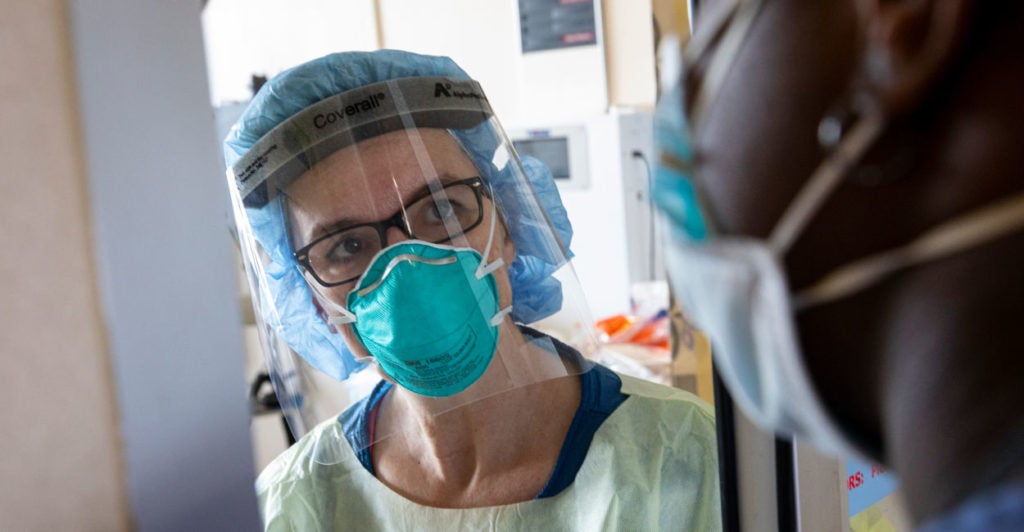The COVID-19 pandemic that has reached every corner of America presents policymakers with a vastly complicated problem that will require a diverse and tailored approach.
Any solution to reopening the country will need to deal with a great variety of locales, as well as to engage with multiple levels of government.
To that end, The Heritage Foundation’s National Coronavirus Recovery Commission recently released recommendations for reopening the country that would begin to return the country to a degree of normalcy while ensuring the backstopping of the health system in case of a resurgence.
>>> When can America reopen? The National Coronavirus Recovery Commission, a project of The Heritage Foundation, is gathering America’s top thinkers together to figure that out. Learn more here.
The commission’s recommendations list specific action items, not just for local, state, and federal governments, but also for private industry and civil society at large.
Although public health strategies are led by government actors, they succeed or fail by the public’s involvement and cooperation. The commission’s recommendations recognize the need for the “whole of society” to participate and provides guidance for it to move forward.
In other words, these recommendations lean precisely on the strengths of the founding principles of the country to guide us through the threat of this novel coronavirus.
The document starts with “Saving Lives and Livelihoods: Recommendations for Recovery.”
That highlights one important aspect that’s missing from much of the discourse, that life and livelihood cannot be separated. They are on a continuum for a person, and if the government crushes livelihood to save life, both will be lost.
This set of recommendations is the first of several that are planned. It covers the first two phases of the commission’s five-phase plan for recovery, which are to “return to a more normal level of business activity at the regional level” and to “slow the spread of the coronavirus while expanding testing, reporting, and contact tracing.”
The first recommendation is directed to states, which have been the main actors against the virus, to identify and reopen counties with low incidences of COVID-19.
Even in the hardest-hit state in the country, New York, there are many counties with fewer than 100 cases. Hamilton County, for instance, as of now, has just three cases, and Lewis County has only nine.
There are potentially more infected people in the community, but these counties would benefit from state-level resources being directed there to assist with testing and contact tracing.
With so few cases, the health department may be able to completely cut off the spread of infection in those counties by quarantining those cases and contacting those who may have been exposed to those cases and quarantining them as well.
As of this writing, there are 31 counties in New York that are reporting fewer than 100 cases. If there is enough testing in those areas and few enough new daily cases, they are primed for contact tracing and then reopening.
Every state should establish metrics and criteria, and begin identifying counties to begin reopening.
It’s important to remember that “reopening” must occur in phases, with the lowest-risk populations and sectors opening first with a continued adherence to social distancing guidelines.
Other recommendations for states address regulatory burdens that have hampered pandemic response.
When cases of a highly infectious and potentially deadly pathogen threaten to overwhelm the health care resources in New York City, very few people care that a nurse is licensed in Kentucky, but not in New York.
As the pandemic begins to subside, occupational licensing requirements and other such requirements will hinder people returning to work by placing unnecessary costs on entering parts of the workforce.
The White House published a series of guidelines that states, workplaces, and individuals should follow as the country relaxes its mitigation strategies.
These guidelines are short of a centralized national strategy, because that would ultimately prove inadequate. Rather, the federal government’s best role in national recovery is coordinating supplies and information, and ensuring that the federal bureaucracy doesn’t hinder a state’s ability to reopen.
As such, the commission recommends that the federal government clear obstacles for national supply chains to backstop supplies and resources that states might need for reopening.
States and localities will need to be confident in their ability to withstand a resurgence, so the federal government should also mediate between states to ensure that limited supplies go to states with greater need and greater potential need.
One of the areas that the White House has been doing well is communicating to the public. The commission also recommends that it continues the coronavirus task force briefings in which America hears national updates from some of the top minds of the public health field.
Drs. Deborah Birx and Anthony Fauci in particular have enjoyed positive approval ratings by communicating complicated information in a comprehensible manner and providing a clear-eyed view of the situation.
In other words, those two doctors are giving Americans a transparent look at COVID-19 in America that edifies the public and defies partisan narratives. The White House has done well to give them such a prominent platform and should continue to do so.
The country continues to struggle with the COVID-19 pandemic, but things are starting to turn around.
While those are some of the recommendations and their implications, there are many more for all levels of government and society. As we move closer to reopening parts of the country, there’s still much we don’t know, but just as importantly, there is also much that we do know.
The lockdown must end at some point. The National Coronavirus Recovery Commission’s recommendations are a careful plan filled with the granular details that should let us as Americans proceed not with fear, but with courage.
